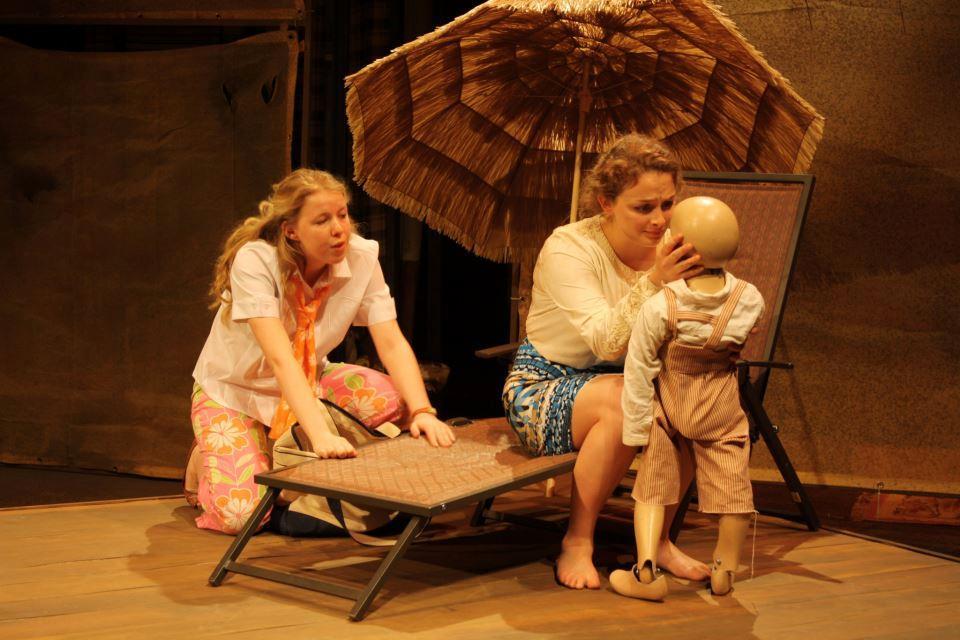“Trojan Barbie,” presented by the Department of Theatre and Performance Studies, is where the violent past and present collide in a confusingly beautiful adaptation of Euripides’ ancient classic, “Trojan Women.”
Upon entering the Gonda Theater, you immediately become part of the violent and disjointed world of the play. Dismembered Barbie dolls caught in barbed wire are strung above the audience, and Joan Jett’s “Bad Reputation” is blaring — it seems like you’ve entered a rock concert rather than an adaptation of an ancient Greek drama. Yet this strange collision of ancient Troy with the modern day is exactly what playwright Christine Evans was hoping to achieve.
“I wanted to do more than adapt Euripides’ play and to bring this work into dialogue with the modern experience of warfare,” said Evans, the newest faculty member of Georgetown’s Theater and Performance Studies program.
Evans’ “Trojan Barbie” blends Euripides’ story with present-day images of AK-47s and modern soldiers. Evans was inspired to create this “car-crash encounter” of two different ages after seeing images of the Iraq War.
“It was an unreal feeling to be at war but only remotely,” Evans said. “It struck me that this collision of times and cultures was a signature of our own times, and I wanted to bring this post-modern sense of temporal dislocation into my play.”
The original Euripidean tragedy follows the plight of the women of Troy after its savage destruction by the invading Greek army. Their husbands have been killed in the war, their children and remaining family members are preparing to be enslaved by the invaders and each woman has her own individual tragedy to weather amid the destruction of her beloved ancestral homeland.
Though the Trojan women come from all walks of life and social strata, they are all tied by the bond of their impending tragic futures. It doesn’t matter if they are the princess of Troy or a simple peasant mother — the darkness of violent invasion touches them all equally. Some, like Cassandra, are cursed and driven mad. Others, like Andromache, are destined to live out their lives as concubines to the generals of the conquering armies.
While it was only considered second best at the City Dionysia drama competition when it was released in 415 B.C., in the 2,500 years since then the work has come to represent the pinnacle of ancient tragic theater. This tradition and the commonality of these images of war make “Trojan Barbie” a unique theater experience.
At times, the blending of contemporary images with myth can be overwhelming for the audience, especially for those unfamiliar with the story of “Trojan Women.” The plot switches quickly from the poetic grieving of the Trojan women — who act as sort of chorus — to modern-day soldiers barking out orders through bullhorns.
This weaving of two conflicting time periods may seem daunting for some.
“There are these extraordinarily realistic moments and then there’s this weird place,” Zoe Lillian (COL ’13), who plays the bratty yet lovable rebel Polly X, said. “Is it 3000 years ago or two years ago? Is it Baghdad or is it Turkey?”
While the concept of a car-crash encounter can be confusing, the commentary of “Trojan Barbie” on the human costs of war is clear. In her mournful monologues, the mother Hecuba illustrates the utter death and destruction caused by the Trojan and Iraq Wars. Realizing how blind characters like Lotte — a British doll-mender on holiday played by Alice Neave (COL ’16) — are to the suffering around them leads the audience to consider how passive we maybe toward war. Have we, like Lotte, ignored the Trojan women?
Another benefit of the collision of two time periods is the resulting mixture of language. Hecuba and the other Trojan women describe the destruction in illustrative poetry. Each monologue is a work of art in and of itself. Meanwhile, the obtuse soldier Mica, played by Ben Prout (COL ’15), serves to make a mockery out of the soldiers and provides much of the play’s comic relief.
“The script is these two balancing acts,” Lillian said. “A big part is the distinction between the poetry with the Trojan women and the non-poetry, a more realistic way of speaking.”
The opposition of lyrical tragedy and satirical humor adds to the many layers of “Trojan Barbie” and speaks to the talent of Evans and the cast.
The impact of “Trojan Barbie” is further increased by the actors’ dedication to their roles. Alexandra Waldon (COL ’15) is stellar in her modernization of the vain and manipulative Helen, complete with a haughty, “mean girl” demeanor. Meanwhile Betsy Helmer (COL ’13) is completely committed to her depiction of the manic and nonsensical Cassandra, a Trojan woman who is misunderstood to be as mentally unstable. All members of the cast push their characters to the extreme, making the show all the more noteworthy.
“Trojan Barbie” is an interesting and innovative look at ancient and modern warfare that is as challenging as it is entertaining. Buckle your seatbelt and prepare for this memorable car-crash encounter.








